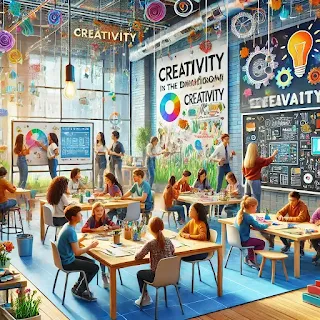Introduction:
Inspiring creativity in the classroom is not just about introducing artistic activities but fostering an environment that stimulates critical thinking, problem-solving, and innovative expression. Scientific research highlights that creativity is a vital skill, not only in the arts but across disciplines, from science and technology to education and business. Encouraging creativity can enhance cognitive development, improve problem-solving abilities, and lead to greater student engagement and academic success. Here’s how educators can inspire creativity in the classroom using research-backed strategies.
Psychologist Carol Dweck’s research on the growth mindset reveals that students who believe their abilities can improve through effort are more likely to embrace challenges and persist in problem-solving. A growth mindset encourages students to view failures as opportunities for learning rather than obstacles. To cultivate this mindset in the classroom, teachers should:
Praise effort, not just outcomes.
Encourage resilience by normalizing failure as a part of learning.
Provide constructive feedback that promotes self-improvement.
2. Encouraging Divergent Thinking
Divergent thinking is the ability to generate multiple solutions to a given problem, a cornerstone of creativity. Studies by psychologist J.P. Guilford emphasize the importance of fostering this type of thinking, which contrasts with the convergent thinking required for standardized tests. Teachers can promote divergent thinking through:
Open-ended questions: Ask questions that have no single correct answer.
Brainstorming sessions: Encourage students to come up with as many ideas as possible without judgment.
Creative problem-solving tasks: Present real-world challenges and ask students to propose various solutions.
3. Integrating Cross-Disciplinary Learning
Research in cognitive science shows that exposure to different disciplines can enhance creative thinking by allowing students to make connections between seemingly unrelated concepts. Cross-disciplinary learning encourages students to apply knowledge from one area to another, sparking creative insights. To implement this:
Combine subjects like art and science or math and literature to foster creative thinking.
Use project-based learning, where students must use multiple skills to complete a task.
Encourage interdisciplinary discussions that challenge students to think beyond their primary focus.
4. Creating a Safe and Flexible Environment
Studies show that creativity thrives in environments where students feel safe to take risks and express themselves without fear of judgment. According to research published in the journal Learning and Instruction, psychological safety is key to fostering creativity. To build such an environment:
Establish a classroom culture that values diverse ideas and perspectives.
Ensure students feel comfortable asking questions and making mistakes.
Allow flexibility in assignments, giving students autonomy over how they approach tasks.
5. Incorporating Play and Imagination
Play is an essential element of creativity, especially in younger students. Psychologist Lev Vygotsky emphasized that imaginative play allows children to explore new ideas and think creatively. Even in older students, play can foster creative problem-solving and idea generation. Techniques include:
Incorporating games that require strategic and creative thinking.
Allowing students to use role-play or simulations in learning activities.
Using imagination-driven prompts for writing, art, or group projects.
6. Use of Technology and Digital Tools
Technology can be an excellent enabler of creativity, allowing students to explore virtual environments, experiment with simulations, or create digital content. Research indicates that students using creative software tools develop enhanced problem-solving and critical thinking skills. Ways to integrate technology for creativity include:
Use design and coding software to foster innovation in STEM fields.
Implement tools like digital storytelling platforms or animation software.
Encourage students to collaborate on digital projects, such as video production or website creation.
7. Promoting Collaboration and Group Work
Social learning theory, as advocated by Albert Bandura, highlights the power of collaboration in learning. Working in groups allows students to exchange ideas, challenge each other's thinking, and develop new solutions collectively. Collaborative activities that enhance creativity include:
Group brainstorming sessions to solve complex problems.
Cooperative learning projects where each student contributes unique skills.
Peer review activities to encourage critical thinking and idea refinement.
8. Providing Time for Reflection
Creativity often requires time to reflect and process ideas. Neuroscientific studies show that creativity is enhanced during moments of rest or when the mind is allowed to wander, which promotes incubation of ideas. To incorporate reflective practices:
Build downtime into the learning schedule for students to reflect on their work.
Encourage journaling or self-assessment activities to help students process ideas.
Allow flexible deadlines for creative projects, giving students the time they need to explore different approaches.
9. Encouraging Curiosity and Exploration
Curiosity is a fundamental driver of creativity. Research by psychologist George Loewenstein suggests that fostering curiosity leads students to explore new areas and become more engaged in learning. Teachers can inspire curiosity by:
Introducing intriguing, open-ended questions to spark interest.
Providing opportunities for inquiry-based learning, where students pursue their questions and research topics of interest.
Encouraging students to explore different perspectives and challenge assumptions.
10. Recognition and Reward of Creative Efforts
Lastly, acknowledging and rewarding creativity can reinforce the value of innovative thinking. According to motivation theories, extrinsic rewards can enhance intrinsic motivation if used correctly. Recognize creativity by:
Offering verbal praise for unique ideas and original solutions.
Displaying creative work in the classroom or online.
Providing opportunities for students to present and share their creative projects with peers.
Conclusion
Inspiring creativity in the classroom involves more than just offering creative tasks; it requires a nurturing environment that promotes curiosity, critical thinking, and open-mindedness. Backed by scientific research, strategies such as fostering a growth mindset, encouraging divergent thinking, and integrating technology and interdisciplinary learning can significantly enhance creativity in students. By implementing these practices, educators can not only inspire creativity but also equip students with the cognitive tools necessary for success in the modern world.
















.png)
0 Comments